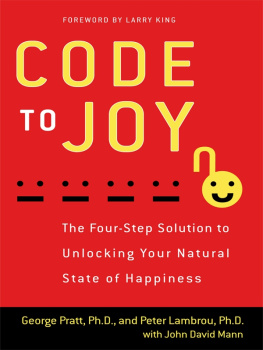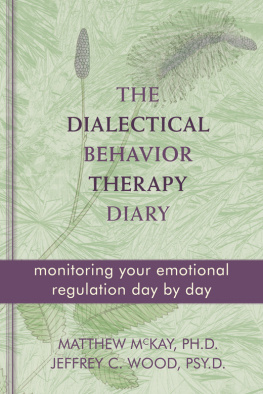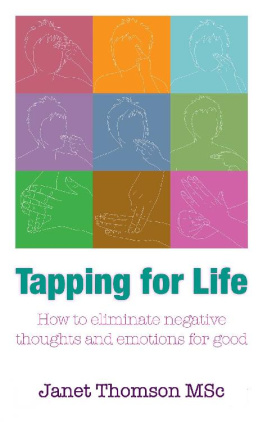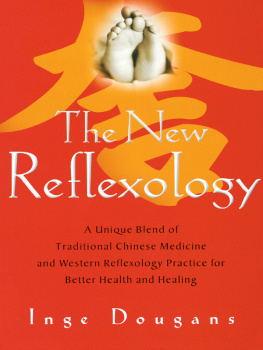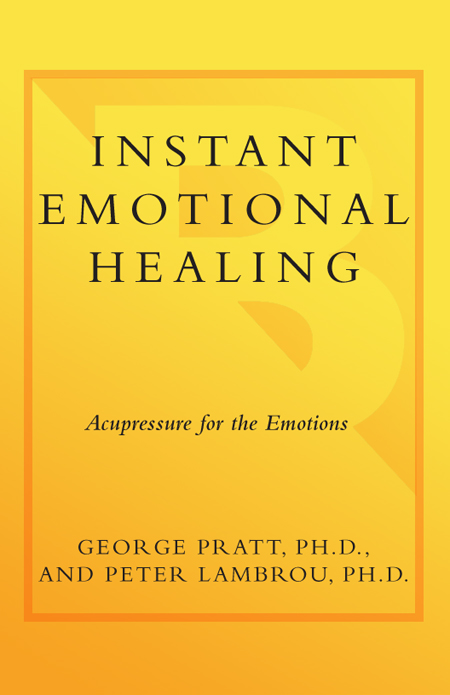ACKNOWLEDGMENTS
We want first to acknowledge the pioneers in the field of energy psychology, from its roots to its many branches. The foundational work of George Goodheart, John Diamond, and Roger Callahan has become the cornerstone of this field. They have paved the way for those who have carried on to explore, expand, and evolve the methods and theories they first laid down.
Margret McBride, our literary agent, has kept the faith and belief in this project, and has inspired and guided us through the labyrinthine hurdles along the publication pathway. She and her staff, Donna DeGutis, Kris Sauer, and others, have been wonderful in helping move this book through the various stages of publishing and beyond.
At Broadway/Random House we want to thank Bill Shinker, who believed in the project; Bob Asahina, who carried it forward; Lauren Marino, who shepherded it through the publication process; Rebecca Holland, for her attentive assistance with graphics and production; Ann Campbell and Cate Tynan, who took care of so many details; and Robert Allen, Kathy Spinelli,Adrianna della Porta, Eleanor Branch, Bob Walter, and many others whose efforts furthered the book on its journey.
Many of our family, friends, and colleagues have contributed feedback, encouragement, and ideas that furthered this project and helped us in a variety of ways. A heartfelt thank you to: Leigh and Tom Adkins; Brian Alman; Marcia and Greg Andrews; Sandra Bagley; Sheila and Paul Banko; Carol and Terry Bassett; Dick Bayer; Nancy and Chris Benbow; Beatrice Benjamin; Ken Blanchard; Cynthia Bolker, Sheldon Bowles; Scott Buchanan; Gregg Burnett; Stacy and Daniel Canfield; Gaetan Chevalier; Zang-Hee Cho; Becky, Dan, Jacob, Mathew, and Luke Cinadar; Melinda Clements; Steve Cobb; Linda Comer; Deane and Doris Dana; Steve and Maureen Dime; Steve Doyne;Brad Eli; Rich Elrod; Scott Finley; Sandy Flynn; Susan Frazar; Fred Gallo; Susan Gawlinski; Julie Gildred; Terry Gopadze; Rebecca and
David Grudermeyer; Nancy and David Haller; Sue Hannible;John Hinsey; Tom Horvath; Robert Howes; Kathy and Ron James; Kitty and Dirk Kingma; Margaret Knight; Kathy and Cliff Koerner; Errol Korn; Lacey Kinelowech; Ann and Mike Kriozere; Pat Kyle; Tammy and Milton Lam-brou; Marilyn Lauer; Bruce Lipton;Judy Liu; Nancy Maher; Margie Dana-Mattingly; Gerald McCracken; Susana Mendez; Cheri and Todd Morgan; Mary Morgan; Mary Jo Mundahl; Mike Nagle; Pam Nathan; Erika Novak; Barbara and K. D. Nyegaard;John Osborne; Audrey Phillips; Karen, David, Grace, and Audrey Pike; Steve Pinterics; Pam Polcyn; Ophelia, Floyd, Sandra, Kenny, Kyle, and Whitney Prater; Pat, David, Chad, Ginger, and Jill Pratt; Patti Quint; Greg Rizzi; Shyla Roberts; Adrienne Rogers; Stu Schrieber; Liza Siegel; Stan Silbert; Cindy Simunec; Greg Smith; Benjamin Spock; Ken Squires; Kay Talley;Toni Thomas; and Marshall Williams.
Our wives, Dottie Lambrou and Vonda Pratt, deserve a special appreciation for their patience and encouragement and for the loving help they provided in taking on extra responsibilities as we focused so much of our energies on completing this book.
An important acknowledgment to Greg Nicosia, who so generously gave of his knowledge, experience, and innovative creativity to help us develop and refine our abilities and to expand our understanding and skills in energy psychotherapy. Greg is not only a psychologist, he is a true healer of the pain and suffering of others. His commitment and dedication to helping others is an inspiration to those who know him. We deeply appreciate Gregs open sharing of his ideas and his feedback on the manuscript.
A very special thanks to our collaborative editor, Laura Torbet, who reshaped our manuscript, reorganized it, fleshed out those areas that were badly in need of structure, smoothed and polished the words, and gave literary life to our case examples. As if that were not a tremendous contribution in itself, Laura also contributed her background in graphic arts to design and direct the graphic elements of this book that are so valuable in helping to explain the intricacies of our methods. We immensely appreciate her literary and visual creativity that blended to make this book so readable and understandable. Every bit as important as her skills were to the books form, her good humor combined with professionalism made our work together a pleasure. Thank you, Laura, also affectionately known as Lulu.
INTRODUCTION
W e are traditionally trained psychologists, originally from the Midwest, who today find ourselves at the leading edge of exciting and controversial new therapies that make extravagant promises.
It wasnt always this way Early in our practices, we both relied strongly on the well-established cognitive and behavioral approaches to psychotherapy. However, throughout our professional careers we have been open to new ideas that could help our clients heal their emotional pain, particularly tools that foster self-reliance and speed up the therapeutic process. Both of us were drawn to hypnosis long before we met.
For a quarter century, George has been a clinical psychologist in private practice, specializing in psychotherapy and performance enhancement. Years before hypnosis became a common therapeutic tool, he was teaching it to physicians, dentists, and psychologists. Along with his gastroenterologist colleague Errol Korn, M.D., he authored hypnosis textbooks as well as videotapes for clinical training.
Peter, who began his career as a professional writer, became fascinated with self-hypnosis when he sought a way of dealing with his own stress. Work pressure had brought on the jaw-clicking and pain that can signal the onset of temporomandibular joint disorder (popularly known as TMJ). After enrolling in a course on self-hypnosis for stress management, a growing friendship with the instructor developed into a collaboration on a book. That writing project in the early 1980s, with hypnosis specialist Brian Alman, Ph.D. (who also had coauthored a book with George), turned Peter in the direction of clinical psychology.
Shortly after our mutual colleague Dr. Alman introduced us, we collaborated on a book that applied self-hypnosis and other skills to achieving business goals. Now, fifteen years later, our personal and professional lives have crossed in many ways. We are in private practice together and are on staff at Scripps Memorial Hospital in La Jolla, California. We also teach at the University of California at San Diego and other professional schools.
As conventionally schooled psychologists, we have cautiously examined therapies that are not well studied and validated by mainstream psychology. Certainly we accept the fundamental connection of mind and body and have approached mental and emotional healing from this perspective for most of our careers. Hypnosis is one potent tool for change. In the past ten years, we have achieved rapid results with EMDR (Eye Movement Desen-sitization and Reprocessing), a powerful and evolving therapy modality developed by psychologist Francine Shapiro, Ph.D.


